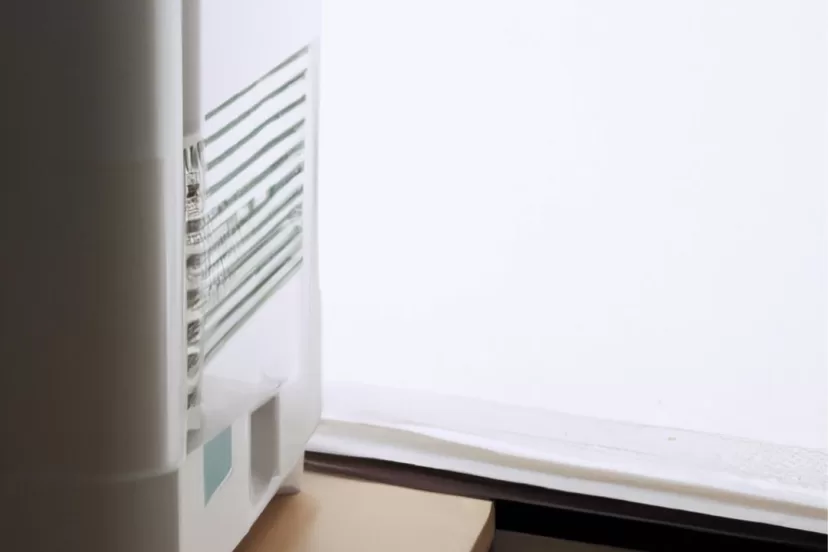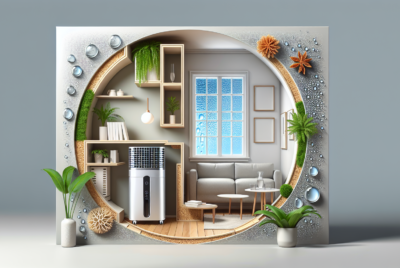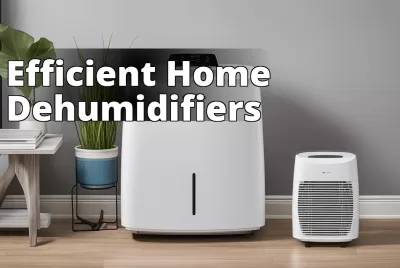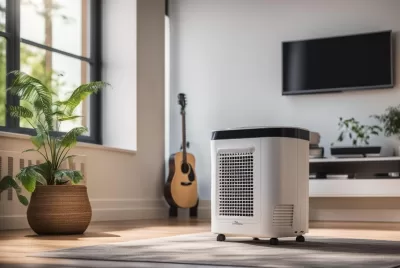Portable Dehumidifiers: Your Solution to Excess Humidity!
"We may earn a commission for purchases made using our links. Please see our disclosure to learn more."
Excess moisture in the air can lead to various problems in your home, such as mold growth, musty odors, and damage to your furniture and belongings. Portable dehumidifiers are compact, easy-to-use devices that can effectively remove moisture from the air, making your living space more comfortable and healthier. In this article, we will explore everything you need to know about portable dehumidifiers, including how they work, key features to consider when buying one, the benefits of using them, and tips for maintaining them properly.
What is a Portable Dehumidifier and How Does It Work?
A portable dehumidifier is a standalone device designed to reduce humidity levels in a specific area, such as a room or basement. It works by drawing in moist air through a fan and passing it over a cold coil or refrigerated coils. As the air comes into contact with the cold surface, the moisture condenses into water droplets, which are then collected in a removable water tank or drained through a hose. The dehumidified air is reheated and released back into the room, effectively lowering the humidity level.
Portable dehumidifiers are equipped with a humidistat, allowing you to set your desired humidity level. Once the humidity level reaches the set point, the dehumidifier automatically shuts off, conserving energy and preventing over-drying of the air. Some advanced models also offer additional features such as programmable timers, digital displays, and automatic defrosting capabilities.
Key Features to Look for When Buying a Portable Dehumidifier
When shopping for a portable dehumidifier, several key features should be considered to ensure you choose the right one for your needs.
1. Capacity and Coverage Area: The capacity of a dehumidifier refers to the amount of moisture it can remove from the air in a 24-hour period, usually measured in pints. It is important to select a dehumidifier with a capacity that matches the size of the room or area you intend to use it in. As a general rule of thumb, a 30-pint dehumidifier is suitable for small rooms up to 1,500 square feet, while a 50-pint dehumidifier is better for larger spaces up to 3,000 square feet.
2. Portability and Size: Portable dehumidifiers are designed to be easily moved from one room to another. Look for models with caster wheels and built-in handles for convenient mobility. It is also important to consider the physical dimensions of the dehumidifier to ensure it fits well in the available space.
3. Noise Level: Dehumidifiers can produce varying levels of noise, depending on the model and fan speed settings. If you plan to use the dehumidifier in a living area or bedroom, it is advisable to choose a model that operates quietly, typically below 50 decibels.
4. Energy Efficiency: Energy-efficient dehumidifiers can help you save on electricity bills while reducing your carbon footprint. Look for models that are ENERGY STAR certified, as they are designed to meet strict energy efficiency guidelines set by the Environmental Protection Agency (EPA).
5. Auto-Defrost Function: If you live in a colder climate, an auto-defrost function is a handy feature to have. This function prevents ice buildup on the coils, ensuring that the dehumidifier continues to operate effectively even at low temperatures.
6. Drainage Options: Portable dehumidifiers come with different drainage options. Some models have a built-in water tank that needs to be manually emptied when full, while others offer the option to connect a hose for continuous drainage. Consider your convenience and preferences when choosing the drainage option that suits you best.

The Benefits of Using a Portable Dehumidifier in Your Home
Using a portable dehumidifier in your home can bring several benefits, both for your health and the overall comfort of your living space.
1. Prevents Mold and Mildew: Excess moisture in the air can create an ideal environment for mold and mildew to thrive. These fungi can cause a range of health problems, including allergies, respiratory issues, and skin irritations. By reducing the humidity levels, a portable dehumidifier helps inhibit the growth of mold and mildew, creating a healthier indoor environment.
2. Reduces Musty Odors: Musty odors are often a result of dampness and mold growth. By removing excess moisture from the air, a dehumidifier can effectively eliminate these unpleasant odors, leaving your home smelling fresh and clean.
3. Protects Furniture and Belongings: High humidity levels can wreak havoc on your furniture, wooden flooring, and other belongings. It can cause warping, cracking, and deterioration of materials over time. By maintaining optimal humidity levels, a dehumidifier helps preserve the integrity and longevity of your valuable possessions.
4. Improves Air Quality: Humid air can feel heavy and stuffy, making it uncomfortable to breathe. A dehumidifier helps to create a more comfortable living space by reducing excess moisture and improving air circulation. This can be especially beneficial for individuals with respiratory conditions, such as asthma or allergies.
5. Enhances Energy Efficiency: When the air is humid, it feels warmer than it actually is, leading to increased reliance on air conditioning. By dehumidifying the air, you can reduce the need for excessive air conditioning, resulting in energy savings and lower utility bills.
6. Prevents Condensation: Condensation can occur on windows, walls, and other surfaces when warm air comes into contact with cooler surfaces. This can lead to water damage, mold growth, and structural issues. A dehumidifier helps to minimize condensation by reducing the moisture content in the air.

Tips for Choosing the Right Size and Capacity of Portable Dehumidifiers
Choosing the right size and capacity of a portable dehumidifier is crucial to ensure it effectively removes moisture from your space without being overworked or underutilized. Here are some tips to help you determine the appropriate size and capacity:
1. Calculate the Square Footage: Measure the area of the room or space where you intend to use the dehumidifier. Multiply the length by the width to get the square footage.
2. Consider the Humidity Level: If your area is extremely humid or prone to excessive moisture, it is advisable to choose a dehumidifier with a larger capacity to handle the higher humidity levels effectively.
3. Account for Dampness: If the room or space has a tendency to be damp due to factors like poor ventilation or water leaks, consider selecting a dehumidifier with a higher capacity than what the square footage alone suggests.
4. Consult the Manufacturer’s Recommendations: Most dehumidifier manufacturers provide guidelines or charts that suggest the appropriate capacity based on square footage. Use these recommendations as a starting point in your decision-making process.
5. Seek Professional Advice: If you are unsure about the size and capacity requirements for your specific needs, consider consulting with a professional HVAC technician or a knowledgeable salesperson who can provide expert guidance.
Best Practices for Properly Maintaining Your Portable Dehumidifier
Proper maintenance of your portable dehumidifier is essential to keep it running efficiently and prolong its lifespan. Follow these best practices to ensure optimal performance:
1. Regular Cleaning: Clean the air filter regularly to remove dust, debris, and other particles that can hinder airflow and reduce the dehumidifier’s efficiency. Refer to the manufacturer’s instructions for guidance on how to clean the filter properly.
2. Empty the Water Tank: If your dehumidifier has a water tank, remember to regularly empty it to prevent overflow. Most models have an indicator or alarm that alerts you when the tank is full.
3. Clean and Inspect the Condensate Drain: If your dehumidifier has a drain hose, ensure that it is properly connected and free from blockages. Regularly inspect the drain and clean it if necessary to prevent clogs and backups.
4. Check for Ice Buildup: Ice can form on the coils of a dehumidifier, especially in colder temperatures. If you notice ice buildup, turn off the unit and allow it to thaw completely before resuming operation.
5. Position the Dehumidifier Correctly: Place the dehumidifier in an open area, away from walls or obstacles that can obstruct airflow. Ensure that there is sufficient space around the unit for proper ventilation.
6. Follow the Manufacturer’s Recommendations: Always refer to the manufacturer’s instructions for specific maintenance guidelines and recommendations. Each dehumidifier model may have unique requirements, so it is important to follow the instructions provided.
By following these maintenance practices, you can ensure that your portable dehumidifier operates efficiently, providing you with the desired results and prolonging its lifespan.
Understanding the Different Types of Portable Dehumidifiers on the Market
When shopping for a portable dehumidifier, you will come across different types, each with its own set of advantages and considerations. Here are the three main types of portable dehumidifiers available on the market:
1. Refrigerant (Compressor) Dehumidifiers: This is the most common type of portable dehumidifier. It operates by drawing in moist air and passing it over a cold coil to condense the moisture. The condensed water is collected in a tank or drained through a hose. Refrigerant dehumidifiers are effective in a wide range of temperatures and humidity levels. They are generally more powerful and suitable for larger spaces.
2. Desiccant Dehumidifiers: Desiccant dehumidifiers use a desiccant material, such as silica gel, to absorb moisture from the air. The moist air is passed over the desiccant, which absorbs the moisture, and the dry air is released back into the room. Desiccant dehumidifiers are quieter and more energy-efficient than refrigerant dehumidifiers. They are also effective in colder temperatures, making them suitable for basements or colder climates.
3. Thermoelectric (Peltier) Dehumidifiers: Thermoelectric dehumidifiers use the Peltier effect to remove moisture from the air. They operate by creating a temperature differential across two metal plates, causing condensation to form on one plate. The condensed water drips into a collection tank, and the dry air is released back into the room. Thermoelectric dehumidifiers are compact, lightweight, and produce minimal noise. However, they are less powerful and suitable for smaller areas.
Each type of dehumidifier has its own pros and cons, so it is important to consider your specific needs and preferences when choosing the type that best suits you.
How to Use a Portable Dehumidifier to Combat Mold and Mildew Issues
Mold and mildew can be persistent problems, especially in areas with high humidity or poor ventilation. Using a portable dehumidifier can help combat these issues effectively. Here’s how to use a portable dehumidifier to tackle mold and mildew problems:
1. Determine the Ideal Humidity Level: Set the humidistat on your dehumidifier to achieve the desired humidity level. The optimal humidity level for most homes is between 30% and 50%. However, if you are specifically targeting mold and mildew prevention, aim for a lower humidity level, around 30% to 40%.
2. Place the Dehumidifier Strategically: Position the dehumidifier in the room or area where mold and mildew are a concern. Ideally, place it in the center of the room or near the source of excess moisture, such as a leaky pipe or a damp corner.
3. Run the Dehumidifier Regularly: For effective mold and mildew control, run the dehumidifier continuously or for extended periods, especially in areas prone to excess moisture. If your dehumidifier has a timer function, you can set it to run automatically at specific intervals.
4. Monitor and Empty the Water Tank: Keep an eye on the water tank and empty it as needed. A full tank can cause the dehumidifier to shut off, rendering it ineffective. If continuous drainage is an option, consider connecting a hose to the dehumidifier for hassle-free operation.
5. Inspect for Mold Growth: Regularly inspect the area for any signs of mold or mildew growth. If you notice any, address the issue promptly by cleaning and disinfecting the affected area. A dehumidifier can help prevent future mold growth, but it is not a substitute for proper mold remediation.
Using a portable dehumidifier in conjunction with other mold prevention measures, such as proper ventilation, fixing leaks, and removing excess moisture sources, can significantly reduce the risk of mold and mildew in your home.
Energy Efficiency: Saving Money with an Efficient Portable Dehumidifier
Energy efficiency is an important consideration when choosing a portable dehumidifier. An energy-efficient dehumidifier not only helps reduce your carbon footprint but also saves you money on electricity bills. Here are some ways to maximize energy efficiency:
1. Choose an ENERGY STAR Certified Dehumidifier: Look for dehumidifiers that carry the ENERGY STAR label. ENERGY STAR certified dehumidifiers meet strict energy efficiency guidelines set by the EPA. These dehumidifiers use less energy while still providing effective moisture removal.
2. Select the Right Capacity: Choosing a dehumidifier with the appropriate capacity for your space ensures that it operates optimally without unnecessary energy consumption. Oversized dehumidifiers can lead to short-cycling, where the unit turns on and off frequently, wasting energy. On the other hand, an undersized dehumidifier will have to work harder to maintain the desired humidity level, leading to increased energy usage.
3. Optimize Fan Speed: Most dehumidifiers come with multiple fan speed settings. In most cases, the lower fan speed is sufficient for maintaining the desired humidity level. Higher fan speeds consume more energy and may not provide significant benefits in terms of moisture removal.
4. Utilize Timers and Humidistats: Take advantage of the programmable timer and humidistat features available in many dehumidifiers. Set the timer to run the dehumidifier during off-peak electricity hours or when you are away from home. The humidistat ensures that the dehumidifier operates only when necessary, avoiding unnecessary energy consumption.
5. Maintain and Clean Regularly: Regular maintenance, such as cleaning the air filter and ensuring proper drainage, helps to keep the dehumidifier running efficiently. A clean and well-maintained dehumidifier is more energy-efficient compared to one that is neglected.
By following these energy-saving tips, you can enjoy the benefits of a portable dehumidifier without worrying about skyrocketing energy bills.
Frequently Asked Questions About Using a Portable Dehumidifier
Q: Can I use a portable dehumidifier in multiple rooms?
A: Yes, portable dehumidifiers are designed to be easily moved from one room to another. However, it is important to ensure that the dehumidifier’s capacity matches the size of the room you intend to use it in. Moving the dehumidifier to different rooms allows you to target specific areas or address temporary moisture issues.
Q: How often should I clean the air filter?
A: The air filter of a dehumidifier should be cleaned regularly, typically every two weeks or once a month. However, the frequency may depend on factors such as the level of airborne particles, the environment, and the manufacturer’s recommendations. A clogged or dirty air filter can restrict airflow, reduce the dehumidifier’s efficiency, and potentially lead to mechanical problems.
Q: Can I use a dehumidifier all year round?
A: While it is not necessary to use a dehumidifier continuously throughout the year, it can be beneficial in certain situations. In humid climates or during the wet season, using a dehumidifier consistently can help maintain a comfortable indoor environment and prevent mold growth. During the drier months or in areas with low humidity, you may not need to run the dehumidifier as frequently or at all.
Q: Can a dehumidifier help with allergies and asthma?
A: Yes, a dehumidifier can help alleviate allergies and asthma symptoms by reducing the moisture in the air. Mold, dust mites, and other allergens thrive in humid environments. By maintaining optimal humidity levels, a dehumidifier can help control these allergens and provide relief for individuals with respiratory conditions.
Q: How long does a dehumidifier last?
A: The lifespan of a dehumidifier can vary depending on factors such as usage, maintenance, and quality of the unit. On average, a well-maintained dehumidifier can last between five and ten years. Regular cleaning, proper drainage, and timely repairs, if needed, can help prolong its lifespan.
Conclusion
Portable dehumidifiers are valuable tools for maintaining a comfortable and healthy living environment. By understanding how they work, considering key features when purchasing, and following proper maintenance practices, you can effectively manage humidity levels, prevent mold and mildew growth, and enhance energy efficiency in your home. Whether you live in a humid climate or simply experience occasional moisture issues, a portable dehumidifier can make a significant difference in improving the overall quality of your living space.




